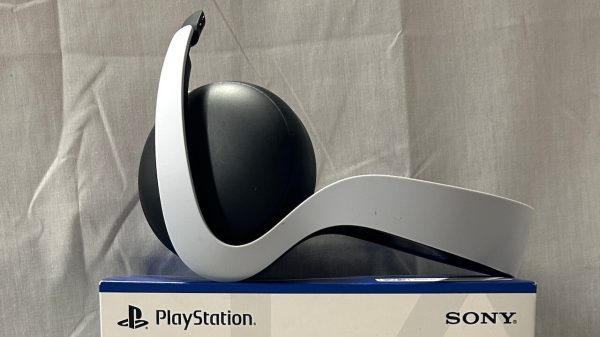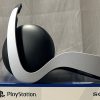It’s been more than a year since I reviewed the Cleer Audio Enduro ANC and while these flagship headphones were more than impressive — the market has already moved on. Think about that. There is so much competition in the TWS and ANC categories that Cleer Audio have just announced the Cleer Alpha which are my topic for this week.
The new Cleer Alpha builds on what Cleer has learned from the Enduro and the Flow Series headphones and incorporates some new features as well.

The Skinny
One thing that will seem familiar to users of older Cleer models is the style and construction. Available in either Stone or Midnight Blue, the Alpha is mostly high impact polymer with a metal headband and hinges for added durability.
The headband is padded well and clamping force is high enough to keep the headphone from moving around under normal conditions. I had no trouble with keeping these from shifting around while on the treadmill. The cups are on the smaller side and on my head, were just barely big enough to be considered an over ear headphone rather than an on-ear.




The outside of the right cup is one big touch sensor so there are only two buttons on the edge of the cups. Starting at the rear, the left cup has a rocker switch for ANC control, the USB Type-C charging port, and LED indicators.
The right cup has the power/pairing button and 3.5mm port for use as a wired headphone and a set of LED indicators. Both cups have a microphone just ahead of the controls at the bottom front of the cup. The LED indicators serve different purposes with the left cup showing charge state and the right being used to indicate Bluetooth pairing status.
The other feature of the cups that I truly appreciate is the ease of pad changes. The pads stay in place well with a combination of magnetic connections, indexing pins, and a rim around the outside of the cup frame that hides the junction when pads are attached.


Removing the pads is just a matter of lifting them off the cup and replacing them is equally as easy. As long as they are close to proper alignment, they simply snap to the proper position with no fuss. Why is it that companies like Cleer have mastered this and I still have to fight for 10 minutes to change pads on headphones that cost over $1000? I won’t mention the brands, but it’s more than one.
The only gripe here is that with isolation comes heat and my ears get uncomfortably warm after a couple hours of listening. The Alpha is far from alone and it is a weakness seemingly all ANC headphones share but it should be a consideration if you don’t really need the isolation and ANC; cloth pads that isolate less are better suited for long wear.

The Alpha folds for easy storage and comes with a hard clamshell case with compartments for the 3.5mm cable and the provided airline adapter in addition to the headphones themselves. The case is relatively compact and fits rather easily in a backpack or computer bag.
Operation
On first use the Alpha went immediately into pairing mode when powered on and pairing went quickly and simply with both my Samsung S21 and iPhone 13 Pro.
One caveat is the Alpha is better suited for Android as it supports aptX Adaptive but not AAC, so the iPhone paired using SBC which is not optimal. Even with the use of SBC, I had no issues with drop-outs using the iPhone.
I found connectivity was good as long as distances were kept within about 10 meters between source and headphones. Interior walls did defeat the signal as rather frequently so it is best to maintain line of sight between headphone and source.
Controls are easy with a swipe forward or back on the right cup moving to the next or previous track respectively. Swipes up and down on the cup adjust volume the same way. Starting at top and swiping down lowers volume, swiping up raises it.

A single touch on the right ear is the play/pause function and the earpieces will automatically stop when removed from your head (This can be turned off in the app if desired).
One other feature I would advise changing on the app is the Auto power off because by default it isn’t turned on and removing the headset will stop the music — but not the battery drain. I set the pair under review to 5 minutes and found it worked well.
The other controls in the app are the ANC/Ambient mode which can be handled by the rocker switch on the left cup; it would be my personal preference to utilize the app for this feature.
The Rocker switch is good for enabling the default level of ANC or the Ambient mode but to enable or disable smart ANC or change the amount of outside sound that gets in the app is much quicker and easier.
The app also has a five band EQ for tuning the sound to your liking and the option to use Dirac Virtuo Spatial Audio. It should be noted that these two are an either/or proposition and that if using Dirac, the EQ is disabled.
The driver used in the Alpha is the latest iteration of the 40mm ironless driver developed at Cleer and used in their flagship Next headphone.
The driver uses a ring of magnets rather than a single iron magnet to improve both the strength and uniformity of the magnetic field created and uses a patented magnesium diaphragm for additional stiffness while maintaining minimal weight.
For more information about the ironless driver, see the video below.
Discussing the sound on the Alpha really needs to be divided into three categories.
The sound is different wired vs wireless with the Cleer manual even stating that HD Audio is only supported in wired mode so there is category 1.
There is a distinct difference to the sound with ANC enabled so ANC is category 2, and likewise Dirac makes a big difference in the sound produced by the Alpha.
Sound
Let’s start by looking at the wired performance of the Alpha using a portable DAP as the source (even when wired these are designed for isolation so a travel scenario makes sense). I connected the Alpha using the provided 3.5mm cable to both an Astell&Kern Kann Alpha (seemed oddly apropos) and a Sony WM1A.
These two represent opposite ends of the spectrum with the AK being slightly warm and thicker sounding, while the Sony is slightly cooler and more analytical.
With the warmer source, the Alpha really does its best work. The music was delivered with strong low end extension with some sub-bass presence but not an exaggerated sub-bass that is so common today. The mid-bass has good note weight and slam without getting wooly in the process; the level of detail and resolution was certainly enough with most genres of music.
The Sony was a little cleaner and more tightly defined in the low end but with less impact for sure.
The midrange has sufficient weight and rather accurate timbre and I was impressed that male vocals were able to push forward in the mix and not lose any of their clarity.
The driver is a definite upgrade over the previous generation in regard to speed, midrange energy, and detail; rock guitar had more than sufficient growl and energy without sounding etched.
Acoustic guitar had a relatively accurate sounding tonal balance but it would have benefitted from some more energy in the upper midrange and lower treble; strings walked the line rather carefully overall and were never fatiguing or too light on detail.

Moving to wireless you do lose some of the detail and clarity, but with aptX Adaptive enabled, it could be hard to spot differences in the wired and wireless modes most of the time.
Unfortunately for Apple users, with SBC enabled, the detail loss was a bit more noticeable and there was rather obvious roll-off in the treble. Some might find these slightly dull with their Apple iPhone in wireless mode.
Adding ANC does help with removing outside noise and did its best work removing lower droning noises but it does introduce some noise of its own to the sound and even with the music turned off, I could hear a mid-frequency hiss introduced when ANC was switched on.
The effect reminds me a bit of tape hiss in the old days and is a common issue with ANC models. Overall, the noise introduced is small enough that I would use the ANC during travel, but enough that when I didn’t really need ANC — I’d forgo it in favor of better sound.
Dirac was another mixed bag for me. The supposed benefit is to introduce a 3D soundfield and I can’t argue that it doesn’t accomplish that. The change in the soundstage is immediately audible, but whether that is a good thing depends largely on the source material.
I will say that I found the Dirac Spatial Audio more natural sounding than either Sony’s Reality Audio or Dolby Atmos for the simple reason that it doesn’t try to recreate a soundstage that is so far removed from the original recording that it sounds completely artificial.
The downside is that voices are sometimes placed in odd locations and tracks can lose a bit of coherency due to their positioning in the soundstage. In fairness, it is a daunting task to try and reproduce the space originally present in a concert hall on a closed headphone and even harder when the original recording was laid down as a series of individual instrument tracks so there are no natural interactions between the voices.
For the most part, I think Dirac is on the right course, but know that it isn’t quite there yet and the odd song may still sound really off when using it.
I found the microphones worked well for phone calls where the only issue was slight wind noise so that was a plus as well.
Battery Life
Another big plus was all this testing came without the need to recharge the battery. Cleer lists the Alpha as having up to 35 hours of battery life and if ANC is disabled and the listening volume is kept at a reasonable level — that number is attainable.
Cleer also lists a quick charge feature that delivers 4 hours of listening on a 10 minute charge (good for short layovers) and while I found it more like 3 hours for a 10 minute charge when the unit was completely drained at the outset, that’s still pretty good. From dead to fully charged takes roughly 5 hours using a standard USB Type-C charger.

Conclusion
The Cleer Alpha does a lot of things well when you consider its $249 asking price. Sure it isn’t quite as adept at ANC as the Sony WH-1000XM4 or Bose 700, but it is also almost $50 less expensive.
I’d also point out that it has better battery life than both (nearly combined). Overall, the audio performance is quite good for the price point; the controls are better than most and easy to use (I prefer the controls to the Sony or Bose), battery life is phenomenal, Dirac is a better Spatial Audio option than most of its competitors, and connectivity is solid with Apple and even better with Bluetooth aptX enabled devices.
It’s a tough market with a lot of big names floating around, but the Cleer manages to find a space for itself and will make a solid travel companion for many looking for a better priced alternative to some of those bigger names.
Where to buy: Was $249. Now $199 at Amazon | CleerAudio.com





































ORT
March 30, 2022 at 2:42 pm
Thank you for an excellent review, sir! Well done, indeed!
I recently bought the top of the Sony WH-1000MX4, two models of Sennheiser – the Momentum 3 and the PCX550-II and the Bose QC45. I bought the QC45 as it was the only one with buttons and I wanted to compare the difference.
Neither the Sennheiser nor the Sony could hold a BlooToof 5 signal and both kept cutting out multiple times and this with either my phone or DAP with me. The QC45 had no such problem.
The touch controls on all three models so equipped left much to be desired. It is not that I do not like touch controls as I have them on my Bose sunglasses, but that the ones on headphones, in a word…suck. This is why I prefer buttons to the touch controls now being made poopular by some one else’s demands. They are convenient, far more tactile that sliding one’s finger around and familiar. What’s that I hear some say? Familiarity breeds contempt? Nope.
It begets COMFORT. As to which model was the most comfortable to wear for minutes or hours?
In order, the QC45, WH-1000MX4, Momentum 3 and PCX550-II.
As for music all four models played music quite well with the standout being the Momentum 3 followed closely by the QC45 and then the WH-1000MX4 and the PCX550-II.
The winner hands down for ANC was clearly the Bose QC45.
I neither want nor need multiple levels of noise control. So long as the process is good, on and off more than suffice. To me multiple levels is naught but marketing and fAd Copy. I used to write ad copy for my wife who was in advertising so I have an inkling of what it is and that “feature” is what I have termed, “fAd Copy”. Some thing to be pushed by what are now called “influencers” and what was termed by a scene from The Beatles film, HELP! (and here I paraphrase) “…She’s a trend setter. It’s her profession.”
Pass.
I bought all four models with but kept only the QC45. I later gave my older brother and his wonderful wife each a pair of Bose QC45 headphone. To me, all four models are pretty durn good but, and every one I know has a big but so here comes mine, the QC45 is the bestest of the best and worth this season citizens hard earned moolah.
ORT